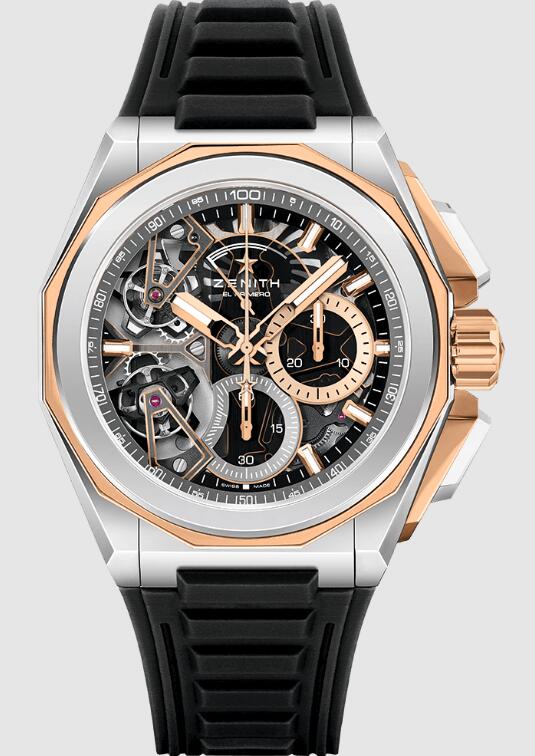
A Defy that will blow your mind.
Are you ready for the extreme limit table?
It’s always been there, lurking in the hidden valleys of Switzerland. But Zenith has gone ahead and revealed it in the latest intro to the Defy series. There’s a lot to absorb here. Clearly. Zenith seems to have moved from the hot Chronomaster Sport and retro-inspired Chronomaster Revival models we saw at LVMH Watch Week in January to—well—more extreme territory. So what exactly are we looking at the new Defy Extreme?
Well, it’s huge. It’s bold. And, it’s worth noting that it’s not a limited production release. The new Defy Extreme is a sub-series production of the 45mm chronograph series powered by the high-frequency El Primero 9004 movement. While movements and exposed dials aren’t new features in the Defy collection, we’ve seen the introduction of specific case profiles that, honestly, are somewhat similar to the minimalist, unforgettable Defy watches created and released under the former CEO of Officer Thierry Nataf was head of Zenith in the late 2000s.
The Defy Extreme collection is available in three different styles at launch, including a microblasted titanium case with black dial trim; a brushed, polished and microblasted titanium case with blue dial trim; a microblasted titanium case with a blue dial trim; Sandblasted titanium and polished rose gold case with gold-plated accents. Zenith also uses the Defy Extreme to launch its new quick-change strap system. As such, every Defy Extreme comes with a matching titanium large link bracelet, with an additional rubber and Velcro strap.
While completely unexpected (at least to me), the iteration of Zenith’s Defy platform starts to make more sense when you think about it. Most people today don’t realize that Defy isn’t actually a modern invention of Zenith, even though it appears to be. The real history of the name Defy can be traced back to the pocket watches produced by Zenith founder Georges Favre-Jacot in the late 1800s. Engraved on the dials of those pocket watches? Défi or “challenge” in English.
Decades later, around the same time Zenith first brought its historic automatic chronograph movement, the El Primero, to the market, the Defy name reappeared as a line of bold sports watches. They feature sharp, angular case designs—check out this 1970s example—and other technical improvements, including enhanced resistance to physical shock and improved anti-magnetic effects on everyday timekeeping. They are rugged steel watches for everyday wear, and their unique designs predate the mass development of the luxury sports watch genre by a few years.
Fast forward to 2017 (skipping Defy’s brief revival in the Nataf era), and Defy was born again, this time home to Zenith’s ongoing experiments in high-frequency watchmaking. We have the Defy Inventor, the Defy Fusée Tourbillon, the Defy Double Tourbillon, the Defy Zero G, and of course the Defy 21 collection as the new flagship. So how does the latest version of the Defy 21 build on a design that most watch collectors might consider already “extreme”?
First of all, we once again have Zenith’s exciting El Primero 9004 chronograph movement, equipped with a double escapement for timekeeping accuracy of up to a hundredth of a second. This means that the central chronograph seconds hand is able to make a lightning-quick revolution around the dial every second. (Seriously – if you have the time to spend some time looking at examples of the Defy 21, you won’t regret it. Interacting with these watches is a mind-numbingly fun experience.) Aesthetically, the lack of a traditional dial is a Not just expected for the Defy 21 model, but expected too – you want to see the secondary escapement zoomed out.
I don’t think Zenith gets enough credit for continuing to develop its iconic El Primero movement. That’s what El Primero 9004 is all about – evolution. It features a fully integrated architecture based on the original El Primero design (great for a 1969 creation, right?), but also incorporates a secondary gear train with a high-frequency escapement that runs at 360,000 vph or 50 Hz, and as a second mainspring barrel. To recap – the normal timekeeping part of the watch is almost the same as the standard El Primero, at 5 Hz, and then the 9004’s second stopwatch-specific part, which is isolated so it doesn’t draw energy from the traditional timekeeping mechanism.
The same goes for all previous entries in line 21 of Defy. But what’s new here is the larger case profile, which transitions from the tonneau shape found on previous Defy 21 watches to a more sculpted, angular form factor with 12 facets. This look complements the original Defy models of the 1960s and 70s, which were released before or alongside other popular multi-faceted sports watches of the time.
The bracelet also seems to be a new product and its lines and overall look immediately caught my eye. Unlike most other integrated bracelets, the Defy Extreme allows you to easily switch between it, the included textured rubber strap, and an extra Velcro strap, thanks to its proprietary tool-free system.
Defy Extreme is basically unapologetic in every way. I think you’ll know at a glance if this watch is right for you. Those who fall in love with it will fall miserably. While it may not catch your eye at first, you should still respect what the Defy Extreme stands for at Zenith. That’s more than 50 years of high-frequency watchmaking, high-mechanical horological engineering and unrestrained – good, refined, extreme – design.
Zenith Defy Extreme Double Tourbillon Yoshida 87.9100.9020 /22.l200
The double tourbillon “YOSHIDA SPECIAL EDITION” is now available from Defy Extreme, a chronograph that can measure 1/100 of a second.
Movement
MOVEMENT El Primero
FREQUENCY 36,000 VpH (5 Hz)
POWER RESERVE approx. 50 hours
Functions
Hours, Minutes, Small Seconds, Date, Chronograph, Column wheel, Tourbillon Escapement
Case
MATERIAL White Gold, Rose Gold
DIAMETER 45 mm
WATER RESISTANCE 3 ATM
DIAL Skeleton
Strap
STRAP Rubber
CLASP Titanium double folding clasp
